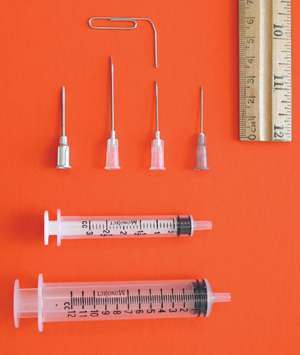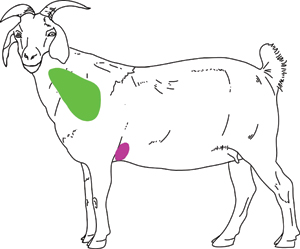Proper Administration of Injections
Administration of injectable medications is sometimes necessary in the routine management of goat herds. The following recommendations are guidelines for proper administration technique for each type of injection. Following these guidelines and using proper equipment and animal-handling methods will reduce stress on animals during treatment. Practicing proper sanitation will minimize introduction of bacteria into medication vials and/or the patient, thereby reducing injection reactions and abscesses. Dirty needles and syringes spread disease if used on multiple animals, so the use of dirty equipment should be avoided. Disposable needles are intended for one use only; more uses can contribute to abscesses at the injection site and can cause animal discomfort. Reusable stainless steel needles can be cleaned and disinfected between animals and used for multiple animals within a healthy herd. When sick animals exist within a herd, producers should not reuse needles. Reusable needles will become dull after six to 10 injections and need to be disposed of properly in a sharps container.
Selection of Needles
The proper technique of giving an injection starts with selecting the correct needle size to accommodate the type of injection. Needle size (gauge) selected should be proportional to the viscosity (thickness) of the medication to be given. The needle bore diameter increases as the needle gauge size decreases (e.g., 18G is larger than 20G). Most goat medications or vaccines can be given with 20 or 22G needles for thin, watery solutions or 18 to 20G needles for thicker medications.
The length of the needle is also relevant to the type of injection and route of administration. For injections under the skin (subcutaneous, Sub Q, or SQ), a ¾-inch needle is appropriate, especially for thin animals. For intramuscular (IM) injections or heavier animals, 1-inch or 1½-inch needles work well. Intravenous (in the vein, IV) is the most difficult injection technique and is usually administered by or under the direction of a veterinarian.
 |
| Needle gauges. |
| Recommended Needle Sizes and Lengths Used with Goats | |||
| Age | Gauge | Needle Length | |
| Intramuscular injection | Subcutaneous injection | ||
| < 4 weeks old | 20 to 22 | ½ inch | ½ inch |
| 4 to 16 weeks | 20 to 22 | 5/8 to ¾ inch | ½ inch |
| 4 to 6 months | 20 to 22 | 1 inch | ½ inch |
| > 6 months | 18 to 20 to 22 | 1 inch | ½ inch |
Subcutaneous Injections
Subcutaneous injections are normally administered by pulling up a pinch of skin to a “tent,” inserting the needle into the base of the tent and parallel to the long axis of the animal’s body. Be careful not to penetrate through to the other side and discharge the medication on the skin.
To give a SQ injection:
- Select or prepare a clean area of the skin. Common sites for subcutaneous injections are the extra skin under the foreleg area or behind the elbow, over the shoulder blade, in the flank area, and on the side of the neck.
- Insert the needle with the bevel facing downward toward the ground; this will lessen the incidence of the drug leaking out of the injection site after the needle is withdrawn.
- Pull back on the syringe plunger and check the syringe hub to see if the needle has been inserted into a blood vessel. If blood is observed, remove or re-direct the needle and try again. If blood is not observed, slowly depress the syringe plunger until the contents of the syringe have been dispensed.
- Massage the site after withdrawing the needle.
- Do not give more than 5 cc (ml) of any medication at one site; divide the amount to be given into multiple injections of 5 cc or less.
IM Medications
IM medications should never be given in muscles that correspond to valuable cuts of meat such as the leg or loin. Any problems with an injection in these areas may necessitate that significant portions of valuable meat be trimmed out and discarded from the carcass at processing. Instead, give IM injections in lower-quality meat cut areas such as the neck.
Injection sites are very important if you market your animals. Quality assurance programs are developed to educate youth (4-H and FFA) and producers on proper injection techniques. Legally, all goats are considered food animals throughout their entire life. Tissue irritation and reactions to injections can manifest as abscesses and scarring of meat and be detected at slaughter; these lesions compromise meat quality, consumer confidence, and producer profitability. Below are illustrations of improper and proper injection sites:
 |
| Not a good injection site. |
 |
| Good injection site. |
 |
| IV injection site used only by an animal care professional or veterinarian. |
References
Meat Goat Production Handbook, Langston University
Quality Assurance :
http://www.luresext.edu/goats/training/mgqa.html
Images provided by Langston University.

